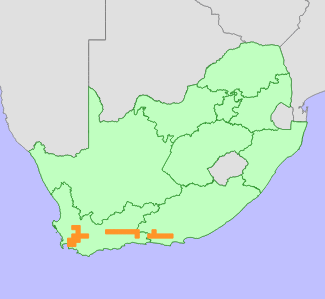|
Scientific Name | Protea rupicola Mund ex Meisn. |
Higher Classification | Dicotyledons |
Family | PROTEACEAE |
Synonyms | Protea dykei E.Phillips |
Common Names | Krans-suikerbos (a), Krantz Protea (e), Krantz Sugarbush (e) |
National Status |
Status and Criteria | Endangered B2ab(iii,v) |
Assessment Date | 2019/09/26 |
Assessor(s) | A.G. Rebelo, H. Mtshali & L. von Staden |
Justification | Protea rupicola has a restricted area of occupancy (AOO) of 344 km² in the Western Cape mountains of South Africa. The population is severely fragmented and there is a continuing decline due to ongoing habitat degradation. This species is slow to mature and too frequent fires are killing individuals before they are able to flower and set seed resulting in ongoing population decline. It is therefore listed as Endangered under criterion B. |
Distribution |
Endemism | South African endemic |
Provincial distribution | Eastern Cape, Western Cape |
Range | This species is endemic to the mountains of the Western Cape Province in South Africa, occurring from the Groot Winterhoek to the Groot Swartberg. |
Habitat and Ecology |
Major system | Terrestrial |
Major habitats | South Hex Sandstone Fynbos, Winterhoek Sandstone Fynbos, Swartberg Altimontane Sandstone Fynbos, Western Altimontane Sandstone Fynbos, Kouga Grassy Sandstone Fynbos, Kouga Sandstone Fynbos, South Kammanassie Sandstone Fynbos, North Kammanassie Sandstone Fynbos, South Swartberg Sandstone Fynbos, North Swartberg Sandstone Fynbos, South Langeberg Sandstone Fynbos, Kogelberg Sandstone Fynbos, Hawequas Sandstone Fynbos |
Description | It occurs on high-altitude summit ridges and rocky cracks where it is protected from fire, 1300-200 m. Mature individuals are killed by fires, and only seeds survive. Wind-dispersed seeds are stored in fire-resistant inflorescences, and released after fires. It is pollinated by birds. |
Threats |
| This species is less transformed (3%) in its habitat, and occurs in fire-safe rocky outcrops. However, as a serotinous reseeder, that is isolated with all subpopulations being small in size, it is vulnerable to increasing frequency of fires, as local extinctions can occur when fires repeatedly kill individuals before they reach reproductive maturity. Also fire-related population declines have been noted. The slow growth rate of Protea rupicola, combined with the current increase in fire frequency and competition with alien invasive species is causing ongoing population decline. |
Population |
This species is known from 43 subpopulations that are localized and more than 70% of these are small and isolated, particularly in the west (Jonkershoek, Hawequa, Worcester and Langeberg) of the distribution range. It is found on fire-safe rocky outcrops, although some subpopulations have disappeared due to fires, which under fire-favourable conditions move through the stands. All known subpopulations in the Groot Swartberg have declined over the last 20 years (Vlok, pers. obs.). Many subpopulations consist of both dead plants, juvenile plants, or old plants that have not yet flowered due to sub-optimal growing conditions. Of the 12 subpopulations (in the Groot Winterhoek, Hex, Hottentot’s Holland and Langeberg ranges) west of the Groot Swartberg Mountains, only three have more than 10 plants. The population is thus severely fragmented and declining.
|
Population trend | Decreasing |
Conservation |
| Almost all subpopulations occur in remote conserved areas: Groot Winterhoek, Fonteintjiesberg, Hawequas, Hottentot’s Holland, Towerkop, Groot Swartberg, Swartberg East, Kammanassie, Baviaanskloof, Kouga, and Bergplaatz Nature Reserves. |
Notes |
| The eastern forms, with capitate pollen presenters and more tree-like growth habit, were formerly recognized as P. dykei E. Philipps. It is not clear though how far west this form occurs and if it is confined to Cockscomb, or extends to the Kouga Mountains, or the Groot Swartberg, as well. These forms should be possibly evaluated separately in future but at present the distributions of these two forms is uncertain. |
Assessment History |
Taxon assessed |
Status and Criteria |
Citation/Red List version | | Protea rupicola Mund ex Meisn. | EN B2ab(iii,v) | Raimondo et al. (2009) | |
Bibliography |
Goldblatt, P. and Manning, J.C. 2000. Cape Plants: A conspectus of the Cape Flora of South Africa. Strelitzia 9. National Botanical Institute, Cape Town.
Manning, J.C. and Goldblatt, P. 2012. Plants of the Greater Cape Floristic Region 1: The Core Cape Flora. Strelitzia 29. South African National Biodiversity Institute, Pretoria.
Raimondo, D., von Staden, L., Foden, W., Victor, J.E., Helme, N.A., Turner, R.C., Kamundi, D.A. and Manyama, P.A. 2009. Red List of South African Plants. Strelitzia 25. South African National Biodiversity Institute, Pretoria.
Rebelo, T. 2001. Sasol Proteas: A field guide to the proteas of southern Africa. (2nd ed.). Fernwood Press, Vlaeberg, Cape Town.
Vlok, J. and Schutte-Vlok, A.L. 2010. Plants of the Klein Karoo. Umdaus Press, Hatfield.
|
Citation |
| Rebelo, A.G., Mtshali, H. & von Staden, L. 2019. Protea rupicola Mund ex Meisn. National Assessment: Red List of South African Plants version 2024.1. Accessed on 2025/12/02 |
 Comment on this assessment
Comment on this assessment

